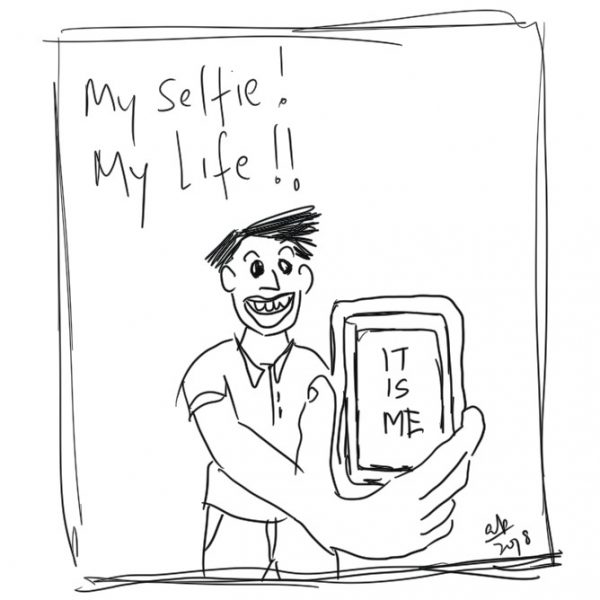We are a country where even morning walkers are seriously reading or watching something on their smartphone and so the phone-peering gentleman driving a car appears less funny. Passing by a Metro station a few days back, I noticed that every battery-operated rickshaw driver was calmly sitting on his driving seat and gazing at a device that looked like a smartphone. The maid at home enters talking on her phone and an hour later exits tapping on the screen. Parents, I’ve heard, are proudly claiming that their toddler knows how to unlock a phone. By the way, does this mean that the toddler will grow into some sort of a Natwar Lal? Phones are everywhere. In fact, I sometimes see them floating in the thick polluted air of Delhi seeking users… and maybe one day they will actually zip around to potential users who will pay to talk, write, click, or play.
A recent article in Economic Times points out that ‘in 2017, Indians downloaded 12.1 billion apps on their phones and tablets, compared to 11.3 billion in the US.’ When I read this I said, ‘Aha! So Indian users are APPidicted!’ I thought I had coined a new word for app addiction but then when I told this to Specky, my wife, she asked, ‘Apps are fine. But what sort of apps? Photo-editing? Drawing? Sketching? Writing? Games? What sort of apps?’
Her question made me research further, and I found out that the Indian mobile gaming market is just 1% of the global pie and that Indians love to download and install apps, including Sonsaur online game, with average apps on a smartphone being 78 and average apps used monthly standing at 43. Netflix had 4.2 million subscribers in January 2017 (KPMG), and Hotstar had 63 million subscribers because it was priced lower and gave away some content for free. The slot paling gacor games can be played on a smartphone. Then there are Amazon prime Video, Viacom’s Voot and a few others suffering because of their subscription model. But YouTube is free… and so are Facebook, Whatsapp, Twitter, and Instagram. Another report done on Indus OS used by more than 3,00,000 Indians points out that the free apps (like Facebook, Whatsapp, Messenger) downloaded took up 40% of a user’s time as compared to 33% in the US. Even Instagram and Twitter lose out here. Thus even being free doesn’t guarantee one a slot in a user’s routine. Other facts that I stumbled upon included the fact that non-English content is currently less but is steadily building up and Google says that between 2016 and 2021, nine out of every 10 new internet users are likely to be Indian-language users.
I showed Specky the output of my search and all she said was, ‘This doesn’t yet answer my question.’
‘You’re so right,’ I said, and added, ‘All that I can add is that we are prevented from being too app-enthused because Indian users patronize a wide range in smartphone specs and most are plagued by varying data speeds. We also have a massive potential in the language sector but then we somehow prefer stumbling through English than gliding with Hindi, so to say. So we’re probably struggling with the language typing keyboard, is it?’
‘Seems unlikely,’ said Specky.
This was when I decided to let the discussion wait for some inspired answer. The answer came soon enough in the form of Carl Ngo, the CEO of Mobiistar who I happened to talk to at the Indiblogger meet. So the first thing I asked him even before he made his presentation, was, ‘Carl, what do you think Indians love to do on their smartphone?’
‘That’s easy,’ said Carl, ‘Indians love clicking selfies.’
Aha! This was one eureka moment that I shared immediately with Specky who was also there. Women aren’t happy with just one question, so she asked Carl, ‘Why just selfies?’
Carl said, ‘Indians love to enjoy more! And selfies give them all the reason to appreciate when good technology is available at a lower price. There is more and you’ll know all about Mobiistar in my presentation.’
In his presentation, Carl did refer to the massive potential in numbers that India has and admitted that this was one reason why he had decided to run his global operations from here. ‘I’m here full-time,’ he said, and added that Mobiistar will focus on service because besides clicking selfies, Indians loved smartphone companies who cared for them even after the sales have been made.
‘Carl speaks from his heart,’ I said, and Specky agreed. Mobiistar had plans to develop the low-cost segment in India, would focus on the social media and digital channels and even talk directly to the consumers. Their aim is simply to invest in mobile technology adoption and to expand the selfie experience in the country. This leading brand from Vietnam and one that has recently expanded to Southeast Asia and Gulf Cooperation Council (GCC) countries has finally come to India with a smartphone that has specs that would match any of the popular brands today… at a price band that would make them twitch nervously. The XQ Dual selfie smartphone will be available for INR 7,999 and the CQ smartphone INR4,999.
There were other details about the phone that we were told and I shall be writing my review post on the specifications and other aspects a bit later. For now let me also add that I was so impressed by the selfie strength of this phone that I wrote a post titled ‘My Selfie Notes’ that you can and must click and read. For those who are in a hurry to know more about Mobiistar, can click here and go to the company website and learn everything about their devices.
By the way, once the mystery of what Indians do with a smartphone was solved, I told myself that India is a massive feature phone and smartphone market with a growth potential that is yet unimaginable. Our country offers size, growth, and potential and statistics say it all. The Indian smartphone market stood at 199.08 million in 2015, is expected to touch 339.95 million by the end of 2018, and the projected size for 2022 is 442.5 million. The language sector is growing and the internet bandwidth is getting faster. Both the span and penetration of mobile devices is confidently sprinting ahead on the belief that the Indian smartphone user will do a lot more than just click selfies. Of course, clicking selfies and sharing them will probably remain an immortal obsession but Indians will intuitively turn to myriad other tasks that this magical device is capable of doing.
.
.
.
.
.
.
Arvind Passey
06 June 2018










